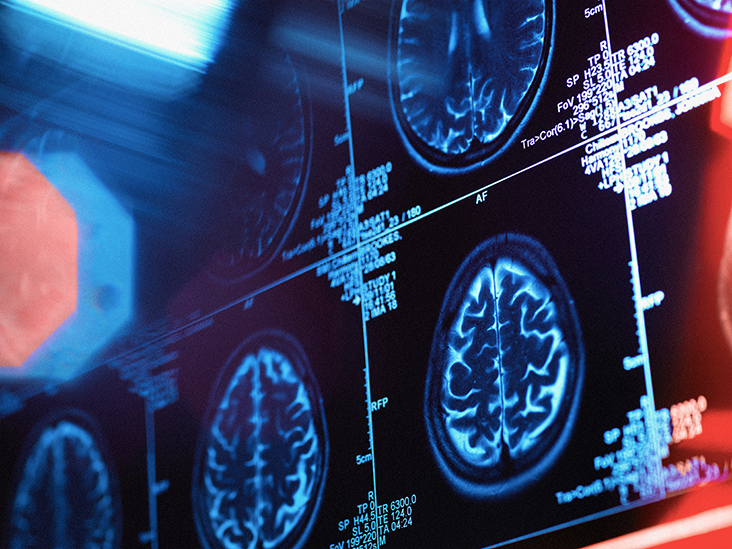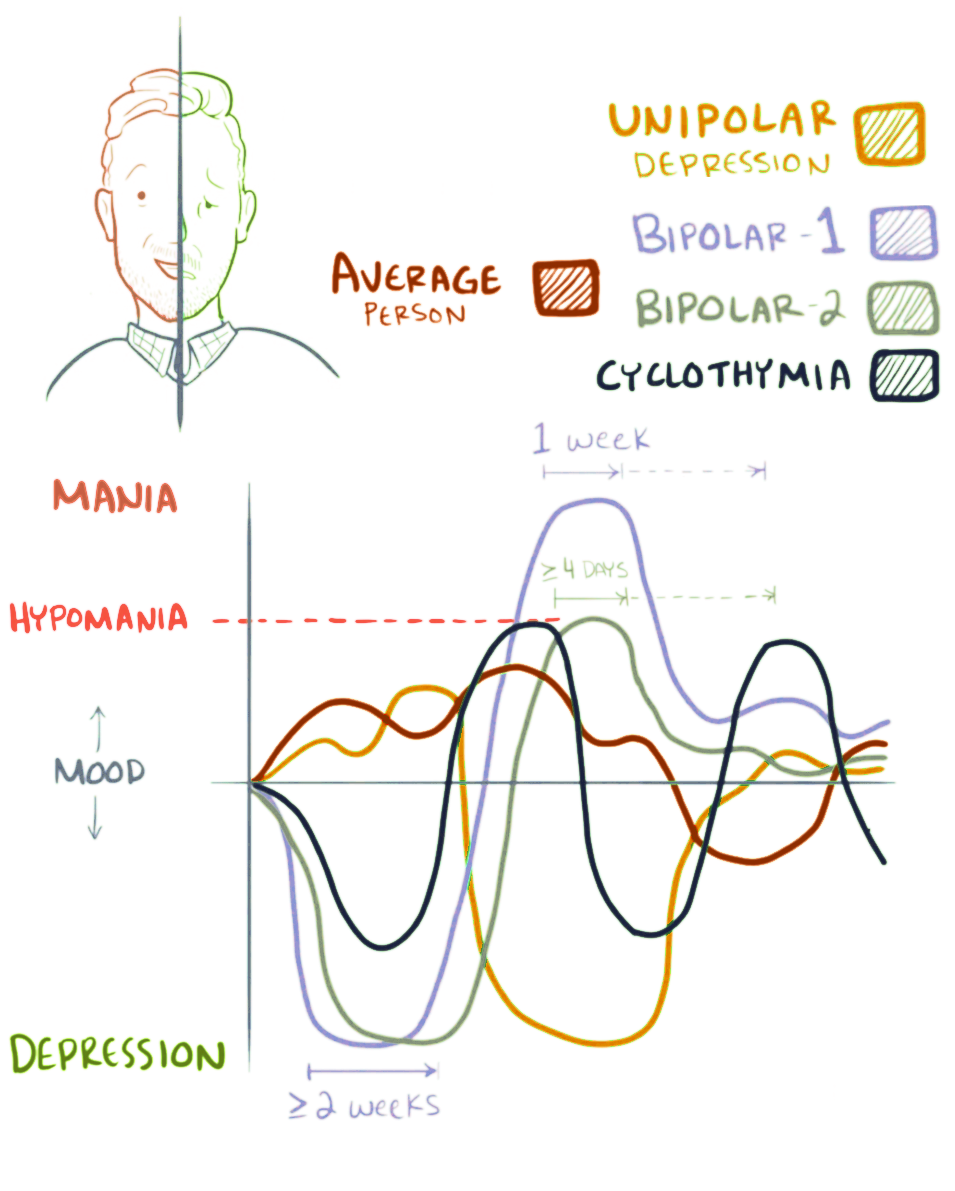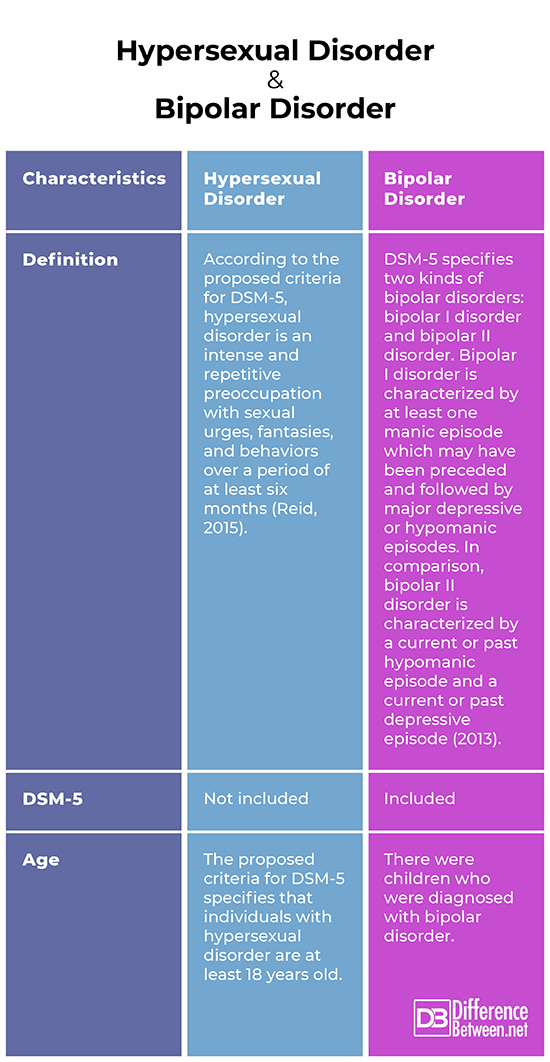Difference Between Hypersexual Disorder and Bipolar Disorder
Hypersexual disorder and bipolar disorder both involve sexual indiscretions such as infidelity, promiscuity, disregard risk of sexually transmitted diseases, and indiscriminate sexual encounters with strangers. Hypersexual behavior is one of the symptoms of manic and hypomanic episode which are criteria of bipolar disorder. For instance, an individual who is in a manic episode may experience intense sexual urges and engage in excessive masturbation and sexual behavior with multiple partners.
Regarding their differences, hypersexual disorder is not included in the 5th edition of the Diagnostic and Statistical Manual of Mental Disorders and it specifically involves an intense and repetitive preoccupation with sexual urges, fantasies, and behaviors over a period of at least six months. On the other hand, DSM-5 specifies two kinds of bipolar disorders which are characterized by alternating high and low mood episodes.

What is Hypersexual Disorder?
According to the proposed criteria for DSM-5, hypersexual disorder is an intense and repetitive preoccupation with sexual urges, fantasies, and behaviors over a period of at least six months. Such preoccupation is not due to exogenous substances, co-occurring medical condition, or manic episodes and has led to clinically significant impairment in functioning. People with this condition are at least 18 years of age and have had multiple unsuccessful attempts to control their sexual behaviors in response to dysphoric mood states and stressful life events (Reid, 2015).
Hypersexual disorder is also referred to as sexual addiction, it is utilized as an umbrella construct to encompass different types of problematic behaviors such as excessive masturbation, pornography use, cyber sex, phone sex, sexual behavior with consenting adults, visitation to strip clubs, and other related behaviors (Karila, et al., 2014). However, other sources differentiate hypersexual disorder from sex addiction; the former refers to experiencing distress regarding a pattern of repeated sexual relationships with a series of lovers who are perceived as mere things to be used while the latter refers to compulsive sexual acts despite harmful consequences (Tidy, 2018).
Hypersexual behavior’s causes are not well understood; the risk factors include traumatic experiences (i.e., sexual abuse), stressors (i.e., family dysfunction, relationship conflicts, and social stress), and mental illness such as depression and anxiety (Psychology Today, 2019). Moreover, hypersexuality is a symptom of bipolar disorder; head injury, epilepsy, dementia, or other neurological disorders have also been known to cause hypersexuality (Kennard, 2020). Treatments may involve rebuilding relationships, identifying triggers, managing stress, behavior therapies, and support groups. Medications may also be prescribed if the condition is associated with anxiety or mood disorders (Kennard, 2020).

What is Bipolar Disorder?
Before going into definition of of bipolar disorder, it is first necessary to understand the following terms (DSM-5, 2013):
Manic Episode
People who have manic episodes have distinct periods of abnormal and persistent elevated or irritable mood, increased energy or goal-directed activity for at least a week. The symptoms include grandiosity, decreased need for sleep, being more talkative than usual, having a flight of ideas, being easily distracted, and having excessive involvement with activities with high potential for harm such as sexual indiscretions, foolish business investments, and unrestrained buying sprees.
Hypomanic Episode
The symptoms for hypomanic episode are the same with manic episode except that they last for at least 4 consecutive days.
Major Depressive Episode
People with major depressive episodes experience at least 5 of the following symptoms during the same 2-week period: depressed mood, significant diminished interest in all or almost all activities, significant weight loss or weight gain, insomnia or hypersomnia, psychomotor agitation or retardation, fatigue, feelings of inappropriate guilt or worthlessness, diminished ability to concentrate, make decisions, or think, and suicidal ideation. It must be noted that at least one of the symptoms is depressed mood or loss of pleasure or interest.
DSM-5 specifies two kinds of bipolar disorders: bipolar I disorder and bipolar II disorder. Bipolar I disorder is characterized by at least one manic episode which may have been preceded and followed by major depressive or hypomanic episodes. In comparison, bipolar II disorder is characterized by a current or past hypomanic episode and a current or past depressive episode. Major depressive episodes often occur but are not required for the diagnosis of bipolar I disorder. Moreover, the National Institute of Mental Health (NIMH) describes bipolar disorder’s main symptoms as alternating high and low mood episodes (Newman, 2020).
The exact cause is unclear; however bipolar disorder appears to result from a combination of factors such as family history, neurotransmitter imbalances, and mental stress. The treatment involves a combination of therapies such as counseling, psychotherapy, medication (i.e., mood stabilizers and antidepressants), physical intervention (hospital treatment), and lifestyle remedies (i.e., healthful diet, regular sleep pattern, and regular exercise).
Difference between Hypersexual Disorder and Bipolar Disorder
Definition
According to the proposed criteria for DSM-5, hypersexual disorder is an intense and repetitive preoccupation with sexual urges, fantasies, and behaviors over a period of at least six months (Reid, 2015). In comparison, DSM-5 specifies two kinds of bipolar disorders: bipolar I disorder and bipolar II disorder. Bipolar I disorder is characterized by at least one manic episode which may have been preceded and followed by major depressive or hypomanic episodes. In comparison, bipolar II disorder is characterized by a current or past hypomanic episode and a current or past depressive episode. Major depressive episodes often occur but are not required for the diagnosis of bipolar I disorder. Moreover, the National Institute of Mental Health (NIMH) describes bipolar disorder’s main symptoms as alternating high and low mood episodes (Newman, 2020).
DSM-5
Hypersexual Disorder is not included in DSM-5 while two kinds of bipolar disorders: bipolar I disorder and bipolar II disorder are under DSM-5’s Bipolar and Related Disorders.
Age
The proposed criteria for the diagnosis of hypersexual disorder specifies that the people with this condition are at least 18 years of age. On the other hand, there were children who were diagnosed with bipolar disorder.
Hypersexual Disorder vs Bipolar Disorder

Summary
- Hypersexual behavior is one of the symptoms of manic and hypomanic episode which are criteria of bipolar disorder.
- Hypersexual disorder is an intense and repetitive preoccupation with sexual urges, fantasies, and behaviors over a period of at least six months.
- The National Institute of Mental Health (NIMH) describes bipolar disorder’s main symptoms as alternating high and low mood episodes.
- Difference Between Hematoma and Melanoma - February 9, 2023
- Difference Between Bruising and Necrosis - February 8, 2023
- Difference Between Brain Hematoma and Brain Hemorrhage - February 8, 2023
Search DifferenceBetween.net :
Leave a Response
References :
[0]American Psychiatric Association. (2013). Diagnostic and statistical manual of mental disorders, 5th edition. American Psychiatric Publishing. Karila, L., et al. (2014). Sexual addiction or hypersexual disorder: Different terms for the same problem. Current Pharmaceutical Design. 20(25):4012-20. doi: 10.2174/13816128113199990619.
[1]Kennard, J. (2020). Signs and symptoms of sex addiction. Very Well Mind. https://www.verywellmind.com/sex-addiction-symptoms-2329082 Newman, T. (2020). What to know about bipolar disorder. Medical News Today. https://www.medicalnewstoday.com/articles/37010
[2]Psychology Today. (2019). Hypersexuality (Sex addiction). https://www.psychologytoday.com/us/conditions/hypersexuality-sex-addiction
[3]Reid, R. (2015). How should severity be determined for the DSM-5 proposed classification of hypersexual disorder? Journal of Behavioral Addictions. https://www.ncbi.nlm.nih.gov/pmc/articles/PMC4712755/#:~:text=The%20proposed%20criteria%20for%20the,to%20adverse%20consequences%20and%20clinically
[4]Image credit: https://post.medicalnewstoday.com/wp-content/uploads/sites/3/2020/09/GettyImages-650160957_thumb.jpg
[5]Image credit: https://commons.wikimedia.org/wiki/File:Bipolar_mood_shifts.png
